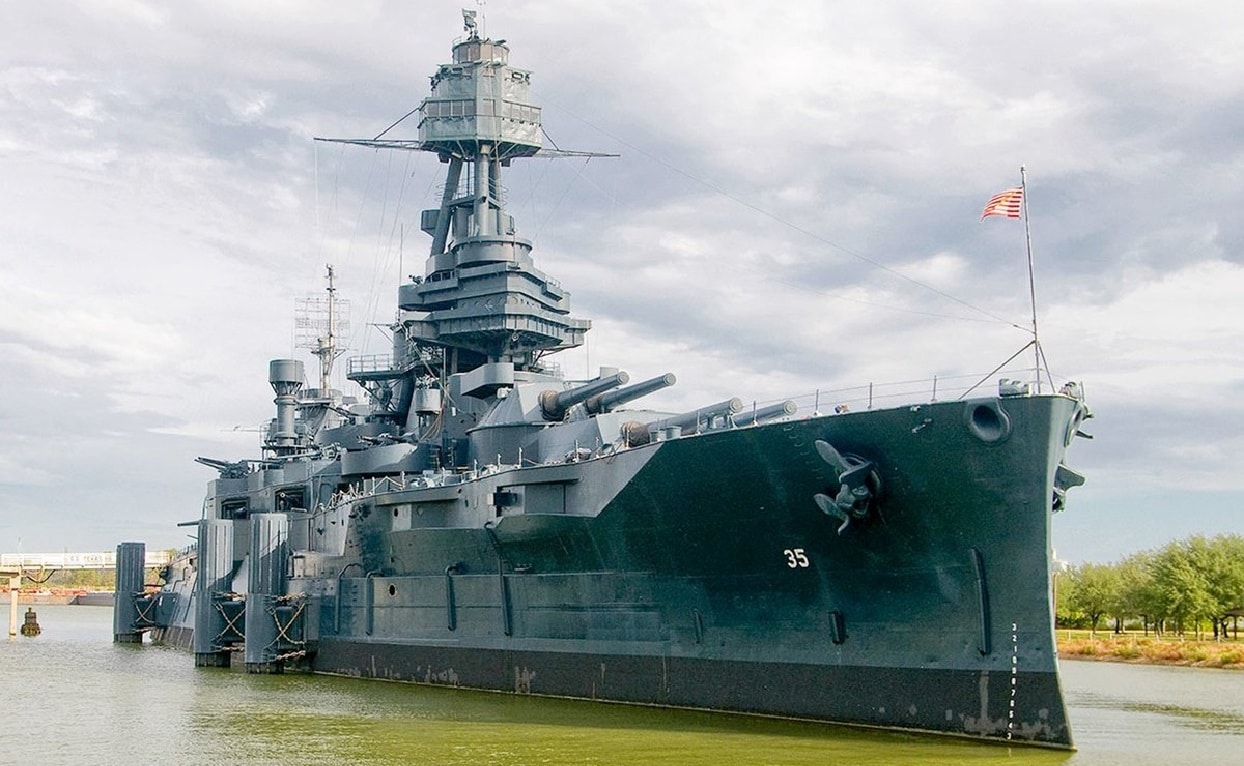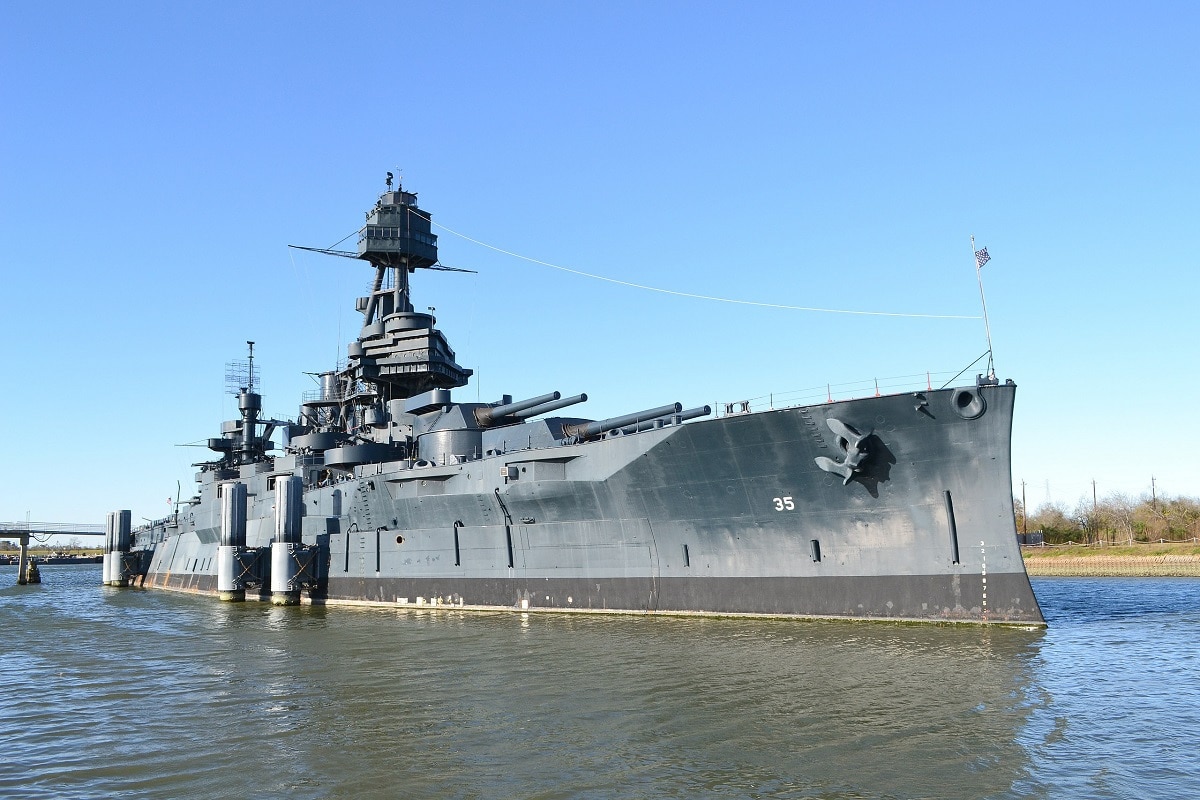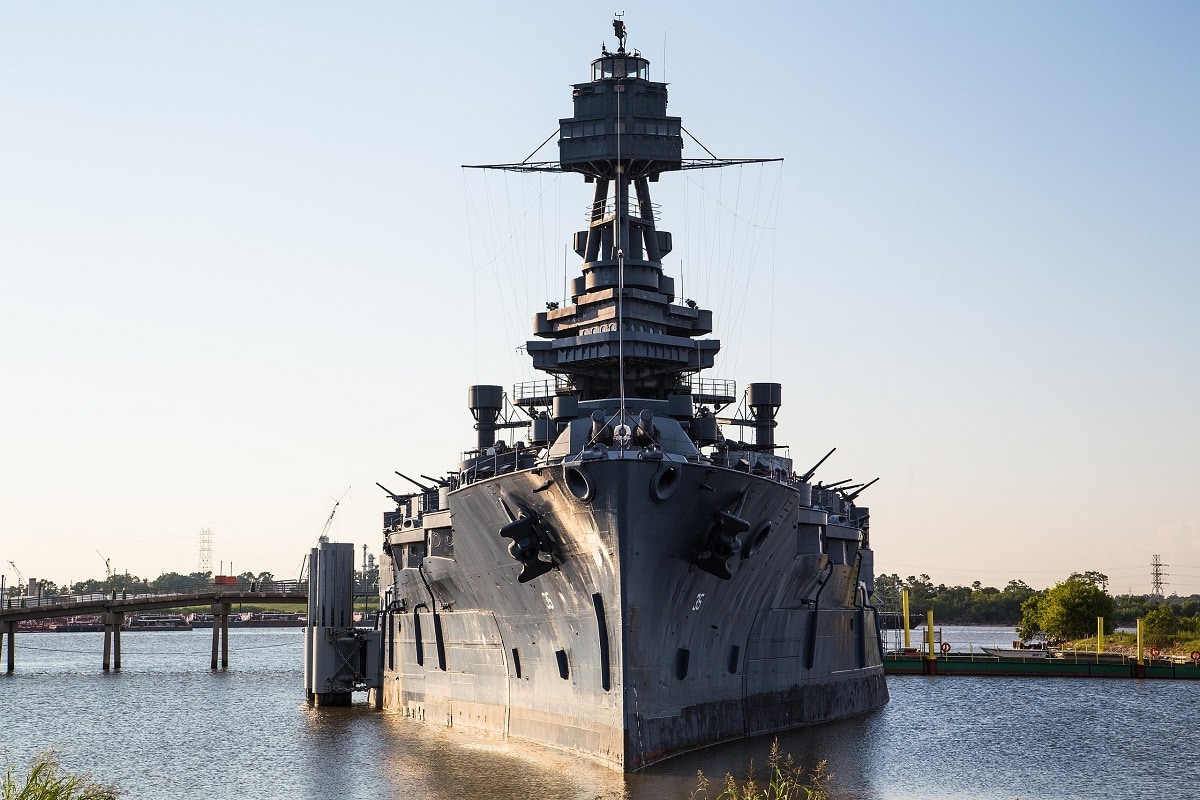Article Summary and Key Points: The USS Texas Finally Finds A Permanent Home – The battleship USS Texas finally has a new home in the port of Galveston.
How USS Texas Became the Homless Battleship…And Now Has a Home
The big dreadnought had been homeless since she was put in dry dock for repairs in August of 2022.
The decision to move the USS Texas—the last remaining World War I battleship—to the Galveston Pier was approved earlier in March by the Galveston Wharves Board of Trustees.
The question of the ship’s home had been in limbo for some time after the Board had authorized and then backed out of a leasing agreement.
In October, the Board cut off negotiations between themselves and the ship’s caretakers, the Battleship Texas Foundation, which turned out to be the push necessary to close the deal.
The Board chose Pier 15 for the battleship. While it wasn’t the first choice for its location, it was still a relief for Tony Gregory, the CEO of the Battleship Texas Foundation.
“We feel like [the vote] opens up a whole new era of things to do, but [with] excitement on the other end,” he told the news service Chron. “We’re very pleased.”
During the board meeting, Vice Chairman Jeff Patterson said that although some details still needed to be worked out, a permanent location for the ship had been determined.
“We have come to a decision on where we can locate the Battleship Texas,” Patterson said. “The two main considerations for this location were really the safety of the channel—that was the driving force that we heard from pilots from the Coast Guard and from the Corps of Engineers.”
Problems Arose With Time, And Restaurants
The old battlewagon developed a large leak that threatened to sink the ship. She finished undergoing a $75 million restoration at the Gulf Cooper Shipyard in Galveston earlier this month. She is now nearly brand new and could open up for tours later this year.
But there was a problem. Her old slip at San Jacinto has closed and won’t reopen. The city of Galveston’s high-dollar restauranteurs want the ship gone, stating that the old girl would ruin the views from their establishments.
The battleship, which the Texas Parks and Wildlife Department owns with the foundation holding a 99-year lease to operate it as a museum ship, “could be [placed] anywhere on port property,” said the USS Texas trustees’ board chairman Victor Pierson.
Background on the USS Texas (BB-35)
The USS Texas (BB-35) was completed in 1914 at the start of World War I. The USS Texas and her sister ship, the USS New York (BB-34), were the first US battleships designed to carry 14-inch (356mm/45-caliber) guns.
The Texas is the only surviving battleship that served in World Wars I and II. But after serving her country in two World Wars, she was retired and now serves as a museum ship, a post she filled since 1948, as the flagship of “the Texas Navy.” She spent 70 years in the Houston Channel near the San Jacinto Battleground, where Texas won its independence from Mexico.
The USS Texas participated in the “Tampico Incident,” which involved the United States occupying Vera Cruz, straining relations between the US and Mexico. She then began fleet operations after America entered the First World War in 1917. She didn’t fire her guns during the war.
Two 4-cylinder Vertical Triple Expansion engines powered the USS Texas, and 14 Babcock & Wilcox coal-fired boilers could provide more than 28,000 horsepower. The ship could reach 21 knots and had a range greater than 7,000 nautical miles.
During the post-war years, from September 1927 to September 1931, Texas became the flagship of the United States Fleet, one of only four ships to be designated U.S. Fleet flagships from 1922 to 1941.
Technological Test Bed Ship
The USS Texas was also a perfect technological testbed for the Navy. It was the first US battleship to mount anti-aircraft guns and the first US warship to control gunfire with directors and rangekeepers.
In March 1919, she became the first US battleship to launch a British Sopwith Camel aircraft from a temporary platform fitted atop her number 2 turret. She was one of the first US Navy warships to receive production radar.
Her ten 14-inch guns could fire 1,400 lb (635 kg) armor-piercing shells for 13 mi (11 nmi; 21 km). Her secondary battery consisted of twenty-one 5-inch (127 mm)/51-caliber guns. Texas also mounted four 21-inch (533 mm) torpedo tubes for the Bliss-Leavitt Mark 8 torpedo, each on the port-side bow and stern and starboard bow and stern. The torpedo rooms held 12 torpedoes total, plus 12 naval defense mines.
For her day, she packed quite a punch.
World War II Service and Retirement
During the bombing of Pearl Harbor, the Texas was in Casco Bay, Maine, on R&R and was ordered to convoy duty. She took part in the first amphibious landing in the Atlantic when she supported “Operation Torch,” the invasion of North Africa. A young Walter Cronkite was on Board the Texas during the battle.
The USS Texas was part of the massive Allied fleet that sailed for “D-Day,” the invasion of France on June 6, 1944. She bombarded the French coast at Pointe du Hoc and the town of Cherbourg and was struck by coastal artillery fire but suffered minor damage.
After being repaired and reassembled in England, the USS Texas participated in the Southern France landing, “Operation Dragoon,” near the French Riviera. Heavy resistance was expected, but the Germans were surprised, and the troops raced inland. She returned to New York and had her main gun barrels replaced.
From there, the Texas sailed through the Panama Canal. After spending Christmas 1944 in Pearl Harbor, she sailed for the Marianas. There, she participated in the naval bombardment of Iwo Jima and Okinawa.
During the two-month campaign in Okinawa, the crew of the Texas remained at general quarters for seven weeks due to the kamikaze threat. They ate only crackers and K-rations for meals, and their only resting time was a quick shower and change of clothes every three days.
After Japan had surrendered, the USS Texas shuttled troops home as part of Operation Magic Carpet. In June 1946, she was inactivated, and the state of Texas planned to tow the ship back to Houston. In 1948, the USS Texas became the first permanent battleship museum in the US.
How Soon Will the Museum Ship Reopen?
There is still some work to do to get the ship ready to reopen. It may reopen as early as this fall, but early 2026 may be more realistic.
The port is building a passenger terminal at Pier 16 for cruise ships, so the adjacent sites should support one another. The foundation has been in contact with MSC, one of the cruise lines renovating the new terminal, about renting out leftover space in one of the old Del Monte warehouses.

USS Texas battleship. Image: Creative Commons.

Image: Creative Commons.

Battleship USS Texas. Image: Creative Commons.
Instead of building a visitor center from scratch, it could use the warehouse space to sell tickets and Battleship Texas merch; the ship would be tied up right outside.
The battleship’s foundation celebrated the good news on social media.
“Big news for Battleship Texas! After years of hard work and dedication, we’re thrilled to have the support of the Wharves Board to bring TEXAS to Pier 15 in Galveston- just a short walk from Pier 21 and the historic Galveston Strand,’ the foundation wrote in an Instagram post. Texas, the last ship of its kind, will promote tourism, educate future generations, and create a visitor experience worthy of her crew and legacy.”
About the Author:
Steve Balestrieri is a 19FortyFive National Security Columnist. He served as a US Army Special Forces NCO and Warrant Officer. In addition to writing for 19FortyFive, he covers the NFL for PatsFans.com and is a member of the Pro Football Writers of America (PFWA). His work was regularly featured in many military publications.

